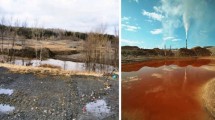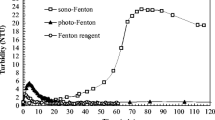Abstract
This study examined a comparative degradation of various chlorinated phenolic compounds including phenol, 4-chlorophenol (4-CP), 2,6-dichlorophenol (2,6-DCP), 2,4,6-trichlorophenol (2,4,6-TCP), 2,3,4,6-tetrachlorophenol (2,3,4,6-TeCP), and pentachlorophenol (PCP) using 28, 580, and 1,000 kHz ultrasonic reactors. The concentration of hydrogen peroxide was also determined in order to investigate the efficacy of different sonochemical reactors for hydroxyl radical production. Clearly, it was observed that the 580 kHz sonochemical reactor had maximum efficacy for hydroxyl radical production. The degradation of all the compounds followed the order; 580 kHz (91–93%) > 1,000 kHz (84–86%) > 28 kHz (17–34%) with an initial concentration of 2.5 mg L−1 at a reaction time of 40 min with ultrasonic power of 200 ± 3 W and aqueous temperature of 20 ± 1°C in each experiment. Overall, the degradation of those phenolic compounds followed the order, PCP > 2,3,4,6-TeCP > 2,4,6-TCP > 2,6-DCP > 4-CP > phenol at various frequencies in the presence/absence of a radical scavenger (tert-butyl alcohol). It was revealed that the correlations between the compound degradation rates and the physicochemical parameters, R 2 = 0.99 for octanol–water partition coefficient, R 2 = 0.95 for water solubility, R 2 = 0.94 for vapor pressure, and R 2 = 0.88 for Henry’s law constant, excluding PCP, were very good in the entire range of each parameter.






Similar content being viewed by others
References
Adewuyi, Y. G. (2001). Sonochemistry: Environmental science and engineering applications. Industrial & Engineering Chemistry Research, 40, 4681–4715.
Ahlborg, U. G., & Thunberg, T. M. (1980). Chlorinated phenols—Occurrence, toxicity, metabolism, and environmental impact. Critical Reviews in Toxicology, 7, 1–35.
Ashokkumar, M., Hall, R., Mulvaney, P., & Grieser, F. (1997). Sonoluminescence from aqueous alcohol and surfactant solutions. The Journal of Physical Chemistry B, 101, 10845–10850.
Ashokkumar, M., Mulvaney, P., & Grieser, F. (1999). The effect of pH on multibubble sonoluminescence from aqueous solutions containing simple organic weak acids and bases. Journal of the American Chemical Society, 121, 7355–7359.
Bapat, P. S., Gogate, P. R., & Pandit, A. B. (2008). Theoretical analysis of sonochemical degradation of phenol and its chloro-derivatives. Ultrasonics Sonochemistry, 15, 564–570.
Benitez, F. J., Beltran-Heredia, J., Acero, J. L., & Rubio, F. J. (2000). Rate constants for the reactions of ozone with chlorophenols in aqueous solutions. Journal of Hazardous Materials, 79, 271–285.
Berlan, J., Trabelsi, F., Delmas, H., Wilhelm, A. M., & Petrignani, J. F. (1994). Oxidative degradation of phenol in aqueous media using ultrasound. Ultrasonics Sonochemistry, 1, S97–S102.
Buikema, A. L., McGinniss, M. J., & Cairns, J. (1979). Phenolics in aquatic ecosystems—Selected review of recent literature. Marine Environmental Research, 2, 87–181.
Buxton, G. V., Greenstock, C. L., Helman, W. P., & Ross, A. B. (1988). Critical review of rate constants for reactions of hydrated electrons, hydrogen atoms and hydroxyl radicals in aqueous solution. Journal of Physical and Chemical Reference Data, 17, 513–886.
Chand, R., Ince, N. H., Gogate, P. R., & Bremner, D. H. (2009). Phenol degradation using 20, 300 and 520 kHz ultrasonic reactors with hydrogen peroxide, ozone and zero valent metals. Separation and Purification Technology, 67, 103–109.
Cheng, J., Vecitis, C. D., Park, H., Mader, B. T., & Hoffmann, M. R. (2008). Sonochemical degradation of perfluorooctane sulfonate (PFOS) and perfluorooctanoate (PFOA) in sandfill groundwater: Environmental matrix effects. Environmental Science & Technology, 42, 8057–8063.
Chowdhury, P., & Viraraghavan, T. (2009). Sonochemical degradation of chlorinated organic compounds, phenolic compounds and organic dyes—A review. The Science of the Total Environment, 407, 2474–2492.
Folke, J., & Lindgaardjorgensen, P. (1985). Organics in wheat and rye straw pulp bleaching and combined mill effluents. 1. Chemical characterization and biodegradation studies. Toxicological and Environmental Chemistry, 10, 1–24.
Francony, A., & Petrier, C. (1996). Sonochemical degradation of carbon tetrachloride in aqueous solution at two frequencies: 20 kHz and 500 kHz. Ultrasonics Sonochemistry, 3, S77–S82.
Gogate, P. R. (2008). Treatment of wastewater streams containing phenolic compounds using hybrid techniques based on cavitation: A review of the current status and the way forward. Ultrasonics Sonochemistry, 15, 1–15.
Gultekin, I., & Ince, N. H. (2008). Ultrasonic destruction of bisphenol-A: The operating parameters. Ultrasonics Sonochemistry, 15, 524–529.
Hao, H. W., Wu, M. S., Chen, Y. F., Yin, Y. W., & Lu, Z. L. (2003). Cavitation-induced pyrolysis of toxic chlorophenol by high-frequency ultrasonic irradiation. Environmental Toxicology, 18, 413–417.
Ho, T. F. L., & Bolton, J. R. (1998). Toxicity changes during the UV treatment of pentachlorophenol in dilute aqueous solution. Water Research, 32, 489–497.
Hu, J. Y., Yuan, T., Ong, S. L., Song, L. F., & Ng, W. J. (2003). Identification and quantification of bisphenol A by gas chromatography and mass spectrometry in a lab-scale dual membrane system. Journal of Environmental Monitoring, 5, 141–144.
Isariebel, Q. P., Carine, J. L., Ulises-Javier, J. H., Anne-Marie, W., & Henri, D. (2009). Sonolysis of levodopa and paracetamol in aqueous solutions. Ultrasonics Sonochemistry, 16, 610–616.
Jiang, Y., Petrier, C., & Waite, T. D. (2006). Sonolysis of 4-chlorophenol in aqueous solution: Effects of substrate concentration, aqueous temperature and ultrasonic frequency. Ultrasonics Sonochemistry, 13, 415–422.
Kang, J. W., Hung, H. M., Lin, A., & Hoffmann, M. R. (1999). Sonolytic destruction of methyl tert-butyl ether by ultrasonic irradiation: The role of O-3, H2O2, frequency, and power density. Environmental Science & Technology, 33, 3199–3205.
Kang, N., Lee, D. S., & Yoon, J. (2002). Kinetic modeling of Fenton oxidation of phenol and monochlorophenols. Chemosphere, 47, 915–924.
Katsumata, H., Kaneco, S., Suzuki, T., Ohta, K., & Yobiko, Y. (2007). Sonochemical degradation of 2, 3, 7, 8-tetrachlorodibenzo-p-dioxins in aqueous solution with Fe(III)/UV system. Chemosphere, 69, 1261–1266.
Keith, L. H., & Telliard, W. A. (1979). Priority pollutants I—A perspective review. Environmental Science & Technology, 13, 416–423.
Kidak, R., & Ince, N. H. (2006). Ultrasonic destruction of phenol and substituted phenols: A review of current research. Ultrasonics Sonochemistry, 13, 195–199.
Kormann, C., Bahnemann, D. W., & Hoffmann, M. R. (1988). Photocatalytic production of H2O2 and organic peroxides in aqueous suspensions of TiO2, ZnO, and desert sand. Environmental Science & Technologie, 22, 798–806.
Krijgsheld, K. R., & Vandergen, A. (1986). Assessment of the impact of the emission of certain organochlorine compounds on the aquatic environment. 1. Monochlorophenols and 2, 4-dichlorophenol. Chemosphere, 15, 825–860.
Lorimer, J. P., & Mason, T. J. (1987). Sonochemistry. 1. The physical aspects. Chemical Society Reviews, 16, 239–274.
Nakui, H., Okitsu, K., Maeda, Y., & Nishimura, R. (2009). Sonochemical decomposition of hydrazine in water: Effects of coal ash and pH on the decomposition and adsorption behavior. Chemosphere, 76, 716–720.
Nanzai, B., Okitsu, K., Takenaka, N., Bandow, H., & Maeda, Y. (2008). Sonochemical degradation of various monocyclic aromatic compounds: Relation between hydrophobicities of organic compounds and the decomposition rates. Ultrasonics Sonochemistry, 15, 478–483.
Okuno, H., Yim, B., Mizukoshi, Y., Nagata, Y., & Maeda, Y. (2000). Sonolytic degradation of hazardous organic compounds in aqueous solution. Ultrasonics Sonochemistry, 7, 261–264.
Puyol, D., Mohedano, A. F., Sanz, J. L., & Rodriguez, J. J. (2009). Comparison of UASB and EGSB performance on the anaerobic biodegradation of 2, 4-dichlorophenol. Chemosphere, 76, 1192–1198.
Rehorek, A., Hoffmann, P., Kandelbauer, A., & Gubitz, G. M. (2007). Sonochemical substrate selectivity and reaction pathway of systematically substituted azo compounds. Chemosphere, 67, 1526–1532.
Scow, K., Goyer, M., & Perwak, J. (1982). Exposure and risk assessment for chlorinated phenols (2-chlorophenol, 2,4-dichlorophenol, 2,4,6-trichlorophenol). Cambridge, MA: Arthur D. Little. EPA 440/4-85-007; NTIS PB85-211951.
Song-Hu, Y., & Xiao-Hua, L. (2005). Comparison treatment of various chlorophenols by electro-Fenton method: relationship between chlorine content and degradation. Journal of Hazardous Materials, 118, 85–92.
SRC. (2006). Syracuse Research Corporation, Interactive PhysProp Database. http://www.syrres.com/esc/physdemo.htm.
STSDR. (1994). Agency for Toxic Substances and Disease Registry (ATSDR)/US Public Health Service. Toxicological profile for pentachlorophenol (update). TSDR, Atlanta, Georgia
Svitelska, G. V., Gallios, G. P., & Zouboulis, A. I. (2004). Sonochemical decomposition of natural polyphenolic compound (condensed tannin). Chemosphere, 56, 981–987.
Teo, K. C., Xu, Y. R., & Yang, C. (2001). Sonochemical degradation for toxic halogenated organic compounds. Ultrasonics Sonochemistry, 8, 241–246.
Vassilakis, C., Pantidou, A., Psillakis, E., Kalogerakis, N., & Mantzavinos, D. (2004). Sonolysis of natural phenolic compounds in aqueous solutions: degradation pathways and biodegradability. Water Research, 38, 3110–3118.
Westerhoff, P., Yoon, Y., Snyder, S., & Wert, E. (2005). Fate of endocrine-disruptor, pharmaceutical, and personal care product chemicals during simulated drinking water treatment processes. Environmental Science & Technology, 39, 6649–6663.
Wu, Z. L., Ondruschka, B., & Stark, A. (2005). Ultrasonic cleavage of thioethers. The Journal of Physical Chemistry A, 109, 3762–3766.
Yim, B., Nagata, Y., & Maeda, Y. (2002). Sonolytic degradation of phthalic acid esters in aqueous solutions. Acceleration of hydrolysis by sonochemical action. The Journal of Physical Chemistry A, 106, 104–107.
Acknowledgements
This research was supported by the Korea Ministry of Environment, “GAIA Project, 02-141-081-021).”
Author information
Authors and Affiliations
Corresponding author
Rights and permissions
About this article
Cite this article
Park, JS., Her, NG. & Yoon, Y. Sonochemical Degradation of Chlorinated Phenolic Compounds in Water: Effects of Physicochemical Properties of the Compounds on Degradation. Water Air Soil Pollut 215, 585–593 (2011). https://doi.org/10.1007/s11270-010-0501-2
Received:
Accepted:
Published:
Issue Date:
DOI: https://doi.org/10.1007/s11270-010-0501-2




